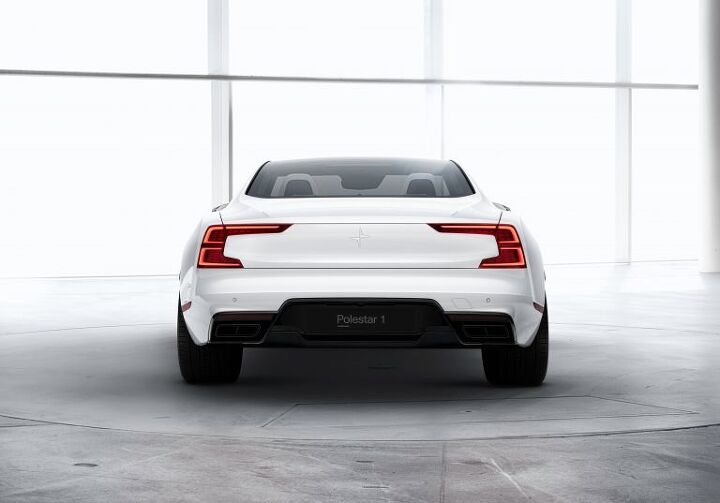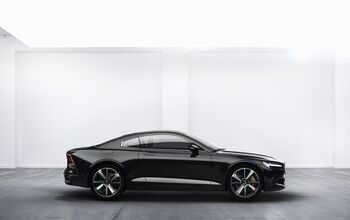Polestar 1: It's Here, It's Real, and It's Not a Volvo

There’s something missing from the efficiently named Polestar 1, the first production vehicle unveiled by the world’s newest car brand: a Volvo badge.
Anyone who’s ever seen Volvo’s 2013 Concept Coupe will surely recognize the similarities between the two vehicles, but the slinky personal luxury coupe seen here is the one you’ll actually see plying a roadway near you, if you’re so lucky. Polestar, once a performance arm of Volvo Cars but now its own standalone subsidiary, plans a range of high-end electrified performance vehicles, of which the Polestar 1 is merely the first.
Packing a 600-horsepower plug-in hybrid powertrain and a body to die for, the 2+2 grand tourer makes great use of its sister division’s architecture, all paid for by corporate overlord Geely. The obvious similarities to the Volvo S90 isn’t an accident, as a bespoke version of that model’s platform lurks beneath its curvaceous flanks. However, that isn’t to say the Polestar 1 is just a Volvo in disguise.
The Polestar’s version of Volvo’s Scalable Platform Architecture (SPA) is 50 percent new compared to the platform used by the range-topping Volvo sedan and wagon. At 14.8 feet in length, the model is significantly shorter than the 16.9-foot-long S90, and boasts a wheelbase reduced by 12.6 inches.
Because steel or aluminum body panels are for plebs, the Polestar 1 wraps itself in carbon fiber, thus ensuring a much stiffer body — 45-percent stiffer, to be exact. Weight drops by 507 pounds compared to the S90.
Under the hood lies a turbocharged 2.0-liter Drive-E Volvo four-cylinder tuned for 218 hp. That engine’s sole job involves motivating the front wheels. Out back, however, twin electric motors deliver 382 hp to the rear wheels, endowing the Polestar 1 with a total torque rating of 737 lb-ft. It’s Polestar’s hope that the model’s 62 miles of all-electric driving satisfies most well-heeled, would-be electric car owners who yearn for unlimited range once in awhile. When charged up, the model turns into a rear-wheel-drive electric performance car, the company claims. It’s up to you whether you use it as an all-wheel-drive hybrid.
With this kind of power on tap, it’s clear the Polestar 1 “will form a halo for the future Polestar brand,” as the company claims. The brand itself serves another purpose.
“Polestar will act as a technology spearhead for the Volvo Car Group, bringing new technology and performance attributes to market,” the company states. “At the same time, Polestar will benefit from technological and engineering synergies within Volvo Cars and significant economies of scale as a result. These synergies will allow Polestar to accelerate the design, development and building of its electrified performance cars.”
Some of that technology is on display in the Polestar 1. Or more specifically, beneath it. The model serves as the debut of the brand’s Öhlins Continuously Controlled Electronic Suspension (CESi), which employs an electronic valve to adjust suspension damping in two milliseconds as road conditions change. The electric rear axle divides the power produced by the twin electric motors via a planetary gearset, providing a torque vectoring system that doesn’t utilize braking to slow down the inner wheel.
Rounding out the handling file are six-piston brakes with 15.7-inch discs on all four corners and a 48:52 front-rear weight distribution ratio. And, should your spirited driving prove too spirited for the Polestar 1’s handling capabilities, repairs are made possible through the Volvo dealer network. Fear not, as you’ll never have to set foot in that dealership. The subscription model includes a pick-up and delivery service, car rentals, and concierge services designed to make you feel special.
It’s obvious the Polestar 1 is a premium car, but with a production limit of just 500 vehicles per year (starting in mid-2018), it’s also poised to become a very scarce car. So, how much does it cost to buy one, you ask? Well, you won’t buy one. Rather, you’ll subscribe to it. Polestar claims the subscription sales model offers “a single, all-inclusive payment that can be topped up by additional on-demand services if required.”
All interactions between Polestar and customers will occur online, and you can bet there’s a handy app available. This, of course, is another reason why the brand’s Volvo ownership comes in handy. Many jurisdictions don’t take too kindly to car companies lacking a dealer network.
What’s next for the Polestar brand? In a word, electrics. The Polestar 1 will be the brand’s only vehicle fitted with a gas tank, with all future models going full electric. In 2019, the company begins production of the aptly named Polestar 2, a higher-volume midsized car designed to challenge the Tesla Model 3. Later, an all-electric SUV, the Polestar 3, joins the lineup and splits the price difference between the low-rung Polestar 2 and top-end Polestar 1.
As for this vehicle’s price, it’s anyone’s guess, but order books for the Polestar 1 opened today. The company wants to collect “expressions of interest” before starting production at the Polestar Production Centre in Chengdu, China.
[Images: Polestar]

More by Steph Willems
Latest Car Reviews
Read moreLatest Product Reviews
Read moreRecent Comments
- Kjhkjlhkjhkljh kljhjkhjklhkjh A prelude is a bad idea. There is already Acura with all the weird sport trims. This will not make back it's R&D money.
- Analoggrotto I don't see a red car here, how blazing stupid are you people?
- Redapple2 Love the wheels
- Redapple2 Good luck to them. They used to make great cars. 510. 240Z, Sentra SE-R. Maxima. Frontier.
- Joe65688619 Under Ghosn they went through the same short-term bottom-line thinking that GM did in the 80s/90s, and they have not recovered say, to their heyday in the 50s and 60s in terms of market share and innovation. Poor design decisions (a CVT in their front-wheel drive "4-Door Sports Car", model overlap in a poorly performing segment (they never needed the Altima AND the Maxima...what they needed was one vehicle with different drivetrain, including hybrid, to compete with the Accord/Camry, and decontenting their vehicles: My 2012 QX56 (I know, not a Nissan, but the same holds for the Armada) had power rear windows in the cargo area that could vent, a glass hatch on the back door that could be opened separate from the whole liftgate (in such a tall vehicle, kinda essential if you have it in a garage and want to load the trunk without having to open the garage door to make room for the lift gate), a nice driver's side folding armrest, and a few other quality-of-life details absent from my 2018 QX80. In a competitive market this attention to detai is can be the differentiator that sell cars. Now they are caught in the middle of the market, competing more with Hyundai and Kia and selling discounted vehicles near the same price points, but losing money on them. They invested also invested a lot in niche platforms. The Leaf was one of the first full EVs, but never really evolved. They misjudged the market - luxury EVs are selling, small budget models not so much. Variable compression engines offering little in terms of real-world power or tech, let a lot of complexity that is leading to higher failure rates. Aside from the Z and GT-R (low volume models), not much forced induction (whether your a fan or not, look at what Honda did with the CR-V and Acura RDX - same chassis, slap a turbo on it, make it nicer inside, and now you can sell it as a semi-premium brand with higher markup). That said, I do believe they retain the technical and engineering capability to do far better. About time management realized they need to make smarter investments and understand their markets better.





































Comments
Join the conversation
I think this might disappoint in person. While I really like the styling, it's not the scale that you'd expect. At two full feet shorter than the S90, it's the same length as a Civic.
I do like it ... it has a bit of the P1800 look to it: http://iliketowastemytime.com/sites/default/files/Volvo-P1800-Wallpaper-wide.jpg Incidentally, the P1800 was just slightly shorter than today's Civic.